Planning a CRM migration? You’ve got options.
CRM migration projects generally follow one of two paths. You can tackle it as an in-house project led by your IT team. Or you can outsource it. Both have significant benefits and classic pitfalls. This CRM migration guide by Cobalt’s AMS, CRM, and data migration experts covers the questions you need to be asking, ways to avoid the most painful mistakes, and resources you can use moving forward. Since many of our partners are associations and/or certification organizations, we’ve also included some specific considerations for membership organizations in this CRM migration guide.
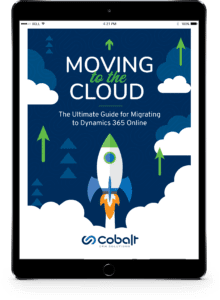
Get your copy of our CRM Migration Guide
Take a copy of this shareable resource that quickly covers the highlights your association or team’s stakeholders will want to discuss for this project.
What’s Included in this CRM Migration Guide
First, let’s note that we’re talking about your “CRM” in this resource, but that’s mostly interchangeable with “AMS” for all the association readers here. There are definitely differences, and we have an entire 2024 AMS Buying Guide that speaks clearly to those differences. But much of what you’ll find here applies equally well to either a CRM system or an AMS system!
Below, we’ve outlined six of the biggest pitfalls and problem areas you’re likely to find in your CRM migration project.
- Downtime during your CRM migration
- A lack of documentation before you move
- How to identify critical data
- Navigating the complex relationships in your CRM data
- Paying too much for cloud storage after you migrate
- Compliance and security risks
In addition, we’ve also offered some advice about each of the four most common variations on the in-house vs outsourced paths for this project.
- Option #1: Partner with Microsoft, Salesforce, etc.
- Option #2: Migrate Data with Your Current CRM Partner
- Option #3: DIY CRM Migrations
- Option #4: Partner with a CRM Migration Team
Let’s start with the most likely problems — and what you can do to avoid them!
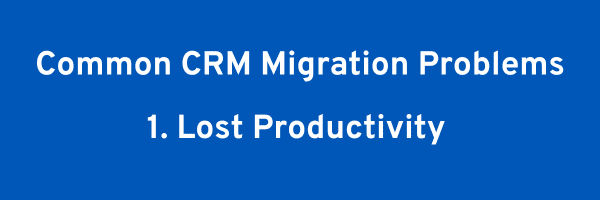
Downtime During Your CRM Migration
Your CRM should be the hub and heartbeat of your organization’s tech stack. In-house IT teams or CRM vendors without extensive data migration experience likely won’t be able to move everything to your new CRM seamlessly. That means you’ll need to plan for downtime that freezes out your CRM users.
How much downtime should you plan for? That’s impossible to say for everyone, but it’s not unreasonable to expect anywhere from 2 to 5 days, if your data structure is fairly straightforward and things go very smoothly for your IT team.
Cobalt has stepped into CRM migration projects that got sideways and left teams without access to the CRM for several weeks. That’s why CRM project rescues have become a niche, specialty offering we provide.
The threat of extended downtime is one of the most common factors in teams delaying a CRM migration or implementation project. It’s also one of the main reasons that organizations opt to outsource these projects. Cobalt’s expertise means our CRM data migration projects have zero downtime for your users. It’s a core part of the value we bring to the table.
If you opt to keep the project in-house, though, there are three things you can do to try and minimize the downtime for your team and whoever you serve.
- Take your time in the data mapping stage of the migration. Extra effort, conversations, and documentation from your SMEs will help the entire process move smoothly and minimize downtime headaches later.
- Before your go-live, migrate and test data in your user acceptance testing (UAT) environment.
- Plan to conduct a smoke test as a part of your go-live process.
- Consider a phased approach where you migrate historical, static data ahead of your cutover so you aren’t trying to migrate everything at once.
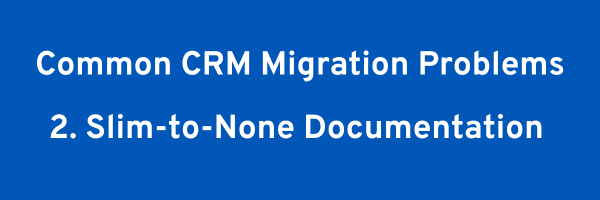
Lack of Documentation Prior to Your CRM Migration
Flexibility and the ability to customize your system is always one of the biggest values for organizations that adopt one of the top-tier CRM systems like Microsoft Dynamics D365. But with great flexibility comes great responsibility … to diligently document those ad hoc modifications to your system!
Has your team done this? The reality is that almost no one does this consistently and methodically from the beginning. When the time comes to migrate data from your old CRM, there’s missing (or no) documentation of data relationships. You might not even have a complete list of entities and fields.
In the end, the true pitfall here is the threat of lost data in your migration project. In order to avoid this, it’s absolutely critical to create reliable data maps before you begin moving data to the CRM system. Believe us when we say that we know how painstaking this part of the project can be, but it’s worth all the hours.
Let’s talk about why.
Migrating data to your new CRM system can offer numerous advantages for associations.
- Accessible and clean data: A CRM system provides a centralized location for all data, making it easily accessible and ensuring its cleanliness through regular updates and maintenance.
- Better functionality: CRM systems offer advanced features and functionalities tailored to the specific needs of associations and chambers, allowing for more efficient operations and member management.
- Quicker ROI: By streamlining processes and improving member engagement, CRM migration can lead to a faster return on investment for associations and chambers.
- Cost savings: With improved efficiency and reduced manual effort, a CRM migration can result in significant cost savings over time.
- Increased productivity: By automating repetitive tasks and providing insights into member behavior, CRM systems can boost productivity for association and chamber staff.
- Better customer service: A CRM system enables associations and chambers to deliver more personalized and responsive services to their members, enhancing overall satisfaction and retention.
- Improved data security: Centralized data storage and robust security measures in CRM systems help protect sensitive information, ensuring compliance with data protection regulations.
Excited to reap the benefits of your data migration?!
It’s great to be excited, but it’s important to be aware of the higher cost involved in a new AMS or CRM implementation as your data migration needs grow. You’ll need to think critically about your most important data.
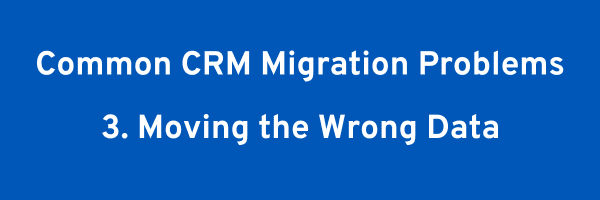
Identifying Critical Data for CRM Migration
In any CRM migration project, one of the most crucial steps is identifying the critical data that needs to be migrated. Your data is the lifeblood of your organization, and ensuring its seamless transition to a new CRM system is paramount to the success of the project.
With complex CRM systems like Dynamics 365, the underlying data structure can be extensive and intricate. This complexity means that not all data is created equal, and not all of it may be essential for day-to-day operations or historical reference.
Before embarking on a CRM migration journey, it’s essential to conduct a thorough assessment of your data to determine what truly needs to be migrated to avoid blowing your budget. This involves:
- Data Mapping: Work with your subject matter experts (SMEs) to map out your existing data structure and identify the key entities, fields, and relationships that are critical for your business processes.
- Data Documentation: Document your data structures, relationships, and any customizations or configurations in your current CRM system. This documentation will serve as a blueprint for the migration process and ensure that no critical data is overlooked.
- Data Cleanup: Take this opportunity to clean up your data by identifying and eliminating duplicate records, outdated information, or irrelevant data. Cleaning your data before migration can streamline the process and improve the quality of your data in the new CRM system.
- Prioritization: Prioritize the migration of essential data that directly impacts your business operations and customer interactions. This may include customer accounts, contact information, sales opportunities, and service tickets.
By identifying and prioritizing critical data for migration, you can ensure a smoother transition to your new CRM system while minimizing the risk of data loss or corruption. Additionally, taking the time to clean up and document your data will set the stage for long-term success with your new CRM platform.
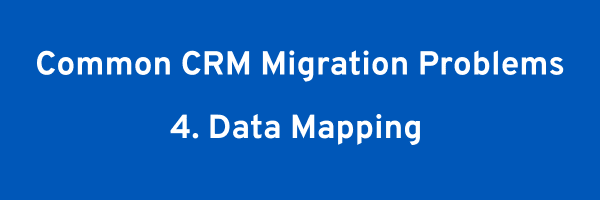
Complex Relationships in Your CRM Data
We’ve already touched on this, but it’s worth underscoring again. AMS and CRM solutions are wildly complex. Microsoft has spent billions in research and development, countless hours of refinement, and amassed one of the most comprehensive, robust software developer communities in the world. It’s built not only for core CRM functionality, but also to integrate virtually infinitely with other systems.
What really sets Dynamics apart from the rest is its ability to be extended for other custom business needs.
At Cobalt we’ve extended the platform to be the perfect AMS. To further illustrate the complexity of building a system like this, we’ve spent over 25,000 hours developing our solution over the past 25+ years.
So, it’s no surprise that D365 is more powerful and complex than smaller, proprietary CRM solutions. Salesforce is the only other CRM on the market that even comes close to what Dynamics 365 can do.
One of the beautiful things about Dynamics 365 however, is that it does a great job of hiding all that complexity under the hood from the end-user. But there are some extremely complex relationships when you look closer. If you’ve ever looked at all the records that make up an email record, you’ll understand.
If you do not have experience handling this complexity, it will be frustrating. And once again, the real pitfall lurking ahead for your team is another possibility of lost data. What can you do to avoid this?
Consult with an expert that does understand those data relationships. Even the high-level investigation and recommendations our team provides in a CRM migration consultation can help your team identify the thorniest data relationships to watch out for in this project.
Generally speaking, though, you’ll want to pay particular attention to:
- Emails and other activities. The ability to track emails in Dynamics 365 is one of its most powerful features but it also provides the biggest headache when it comes to migrations. Mapping the to, from, cc/bcc, and regarding relationships can be overwhelming if you aren’t familiar with the structure. And don’t forget attachments. They aren’t complex, but they’ll definitely slow your migration down to a crawl so you may want to consider migrating them separately.
- The product catalog. If you leverage different units of measure and/or price lists in your quotes, opportunities, orders, or invoices this will add another level of complexity to your migration. This is also great example of migrating data in the correct order. If you don’t get all of your products pushed in before you tackle the tables that reference them (e.g. quotes) you are going to see a lot of failures.
These are the first two items we look at when estimating the level of effort for a migration. That’s how much of an impact they can make.
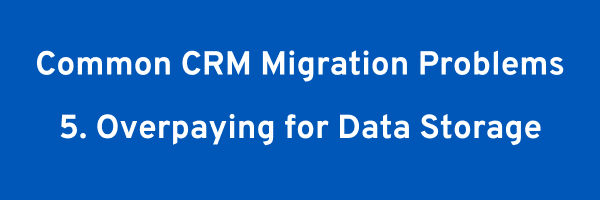
Paying Too Much for Online Storage with Your CRM in the Cloud
Many organizations recognize the cost-savings potential of moving their on-premises CRM to a cloud-based CRM solution.
Just imagine the surprise and infuriating news when a company pulls off a CRM migration project and then gets hit with a heavier bill from Microsoft than they anticipated. We’ve seen it happen when organizations don’t fully understand the online storage cost pricing structure for Dynamics 365.
Important side note: many companies also pay more than they should for D365 user licenses. This can often add up to tens of thousands more per year and it’s why Dynamics 365 pricing optimization is another niche expertise we provide.
When it comes to avoiding a big online storage cost bill from your CRM, there’s a critical conversation to have before the project is even in motion. How much of your data do you really need to move? That’s one of the most important early questions you can ask as you build a CRM data migration project plan.
Since the default for most companies is to bring it all — just in case — if you can avoid that before you migrate, you’ll be saving money over the long haul. Helping you see what data is (and is not) critical to bring is another place that a trusted CRM migration partner can help.
Another way to avoid the bloated online storage cost pitfall is to make some savvy decisions about what kind of files and data your team will need in the future. With an on-premises CRM solution, all the PDFs or image files that aren’t optimized for digital presentations are relatively cheap to house. But these are the kinds of assets that can quickly spike your online CRM storage costs each month, which just multiplies over time.
And all of this means we have some unexpected, good news for you. This CRM data migration project is actually the perfect time to do two things that every organization has on their to-do list (but never seem to get to).
- You can use this project as an excuse to clean your CRM data.
- You can also spend the dedicated time it takes to think about your internal workflows, data management best practices, filing structure, and more.
Our team at Cobalt can show you how to do both things (relatively) painlessly. We’ll get that to that very soon.
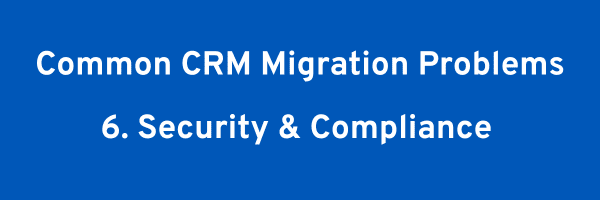
Compliance and Security Risks
Along with the potential for cost savings, this move offers the peace of mind that comes with Microsoft’s industry-leading data security and never needing to wait for another system update. It’s a huge benefit to users to enjoy Microsoft’s generous investments in working to keep your data secure from potential threats.
While you’re navigating your organization’s data migration, keep data security top of mind during every decision. Migrating sensitive customer data between CRM systems can expose organizations to compliance and security risks. Not only is there a risk of it falling into the wrong hands, unprotested, but especially if the data includes personal identification information subject to regulations like GDPR or HIPAA.
If you’re migrating to D365, it’s great to know you’ll be backed by Microsoft’s secure platform, but you’ll still need to ensure that both the old and new CRM systems comply with relevant regulations.
It’s better to be safe than sorry. Always encrypt your data during transfer and work with your data migration partner to conduct security audits post-migration to safeguard against breaches. When it doubt, your software partner should be equipped up front to help you make a plan or respond to a security issue that arises.

Your Team’s Four CRM Migration Options
There are a number of ways you can approach a CRM migration project. Discerning the best option for your company may feel overwhelming. Here is a quick overview of the options you will find on the market today with some specific suggestions for Dynamics customers.
Option #1: Partner with Microsoft, Salesforce, Etc.
With the two largest CRM providers (Microsoft Dynamics 365 and Salesforce), there are some powerful migration options with your respective provider. Salesforce houses this under their professional services offering. For Microsoft Dynamics customers, the Fast Track Migration Program has many benefits for the organizations that qualify. If you are a larger Microsoft Dynamics CRM customer and will require more than $100K per year in Dynamics 365 licenses, this might be your best route. Microsoft’s Fast Track migration program provides a turnkey option for migrating to the cloud. Unfortunately, we’ve found that the minimum spend requirements eliminate a lot of Dynamics customers.
Option #2: Migrate Data with Your CRM Partner
If you’re lucky, you already have a CRM partner or managed services provider (MSP) that provides you with great ongoing support. If your partner also has migration experience, that’s even better. But, if they don’t, you might be paying for their learning curve and their quote might put a strain on your budget and timeline.
Wondering if your MSP has the depth of migration experience to protect your data in the move and keep things on budget? Here are three great questions to ask them, and what you should be listening for in their responses:
What should you listen for? Cobalt has led 200+ successful migrations in the last 16+ years and even though our process is solid and highly refined, we’re still fine-tuning our processes. If your prospective CRM migration partner comes back with anything less than 50 successful migration projects, they are still on the long uphill learning curve — and you’ll end up paying for it.
Listen for lowball offers (which is often a sign of hidden costs to come or a lack of expertise — they don’t understand what this project will actually entail) or offers with a range that’s wider than $100,000 (they are hedging because they don’t truly know how much effort it will require from their migration team).
If they have really been developing CRM data migration expertise, then this plan will be well-documented, transparent, and effective. If it’s not all of those things, you might be in for a very difficult transition. You can read more about Cobalt’s CRM data migration checklist here.
Option #3: DIY CRM Migrations
Many organizations at least initially plan to tackle the migration to their new CRM as an in-house project. And with a seasoned, confident IT team, the right plan, documentation, and support from your other staff, there can be a lot of advantages for the DIY option.
You might feel that you understand your CRM system better than anyone else and that you have the technical resources to complete the migration without outside assistance. This is definitely possible, but the cost in staff resources and lost productivity from downtime during the migrations could be more than hiring the right partner.
If you’re still weighing this option, definitely check out our other CRM migration resource articles (we have some listed at the end of this guide!) to help you finalize your plan to move forward.
Option #4: Partner with a CRM Migration Team
This is often the ideal option for organizations that have medium-to-large databases and are somewhere between having no budget for a migration and shelling out for an enterprise-level move to a new CRM.
We’ve mentioned many of the ways our deep expertise with Microsoft Dynamics 365 migrations is valuable for our partners, but there are four things that set us firmly in the top-tier of Dynamics migration vendors:
- Our customized migration tool has already been successfully used in hundreds of simple, safe, smooth CRM migrations with zero downtime.
- We use a refined, iterative process with client feedback and reviews from the beginning of the project through support after your migration.
- Our fixed-cost migration projects take the pricing guesswork out of things for you because we’ve already done the hard work of learning exactly what it takes to pull off these projects.
- Our free evaluation and CRM migration quote process is truly a customer-first experience and quickly gives us a clear look at the core needs of your project.
CRM Migration FAQs
How long does a CRM migration typically take?
The duration of a CRM migration project can vary depending on factors such as the complexity of your current CRM system, the volume of data to be migrated, and the chosen migration approach. Generally, a straightforward migration may take several weeks to a few months, while more complex migrations could extend the timeline.
What are the potential risks of CRM migration?
CRM migration entails certain risks, including data loss or corruption, extended downtime during the migration process, and unforeseen complications arising from complex data relationships. However, partnering with experienced migration specialists and thorough planning can mitigate these risks effectively.
How do I ensure data security during the migration process?
Data security is paramount during CRM migration. Implementing encryption protocols, restricting access to sensitive information, and utilizing secure migration tools are essential measures to safeguard data integrity. Additionally, conducting regular audits and compliance checks can help maintain robust data security practices.
Is it possible to migrate customizations and configurations to the new CRM system?
Yes, it’s possible to migrate customizations and configurations from your existing CRM to the new system. However, thorough documentation of customizations and meticulous planning are crucial to ensure a seamless transition. Working with migration experts who specialize in preserving custom settings can streamline this process.
What level of training is required for end-users post-migration?
End-user training is essential to facilitate a smooth transition to the new CRM system. Training programs should cover basic navigation, data entry procedures, and utilization of key features relevant to each user’s role. Providing ongoing support and resources post-migration can further enhance user adoption and proficiency.
How can I measure the success of a CRM migration project?
Measuring the success of a CRM migration project involves assessing various factors, including data accuracy, system performance, user satisfaction, and alignment with organizational goals. Conducting post-implementation reviews, gathering feedback from stakeholders, and monitoring key performance indicators (KPIs) can help evaluate the project’s effectiveness and identify areas for improvement.
What should I consider when selecting a CRM migration partner?
When choosing a CRM migration partner, consider factors such as their experience with CRM migration projects, expertise in your specific CRM platform, track record of successful migrations, and commitment to client support. Requesting references, reviewing case studies, and conducting thorough evaluations can help ensure you select a reliable and competent partner for your migration needs.
Can I migrate data from multiple sources into a single CRM system?
Yes, it’s possible to consolidate data from multiple sources into a single CRM system through comprehensive data integration and migration strategies. However, this process requires careful planning, data mapping, and validation to ensure data accuracy and consistency across sources. Engaging experienced migration specialists can simplify the integration process and minimize potential challenges.
More CRM Migration Resources
Before we wrap things up, here are links to some of the most helpful parts of this puzzle that will give you more actionable details, tips, and hard-won expertise:
- CRM Data Migration Plan: What’s Important?
- CRM Data Migration Checklist
- Dynamics 365 vs Salesforce: Price and Value Comparison
- Salesforce to Dynamics 365 Migration: 5 Critical Issues
- Must-Ask Questions Before Migrating to Dynamics 365 Online
- CRM Data Management
Connect with Our CRM Migration Experts for a Free Assessment
We’ve successfully completed 200+ seamless, secure CRM migrations and have deep experience you can lean on. If your team is still trying to sort out the best path forward for your CRM migration project, we can help.
Cobalt can surgically assist your current CRM partner with a complicated migration or take your team from start to finish if you need a new partner. Just request a free CRM assessment. We’ll schedule an introductory call to meet your team and help you clearly see the options for your organization.
